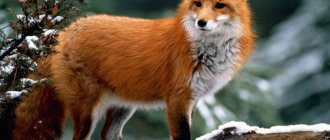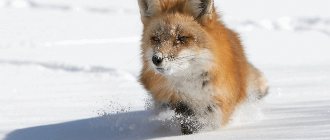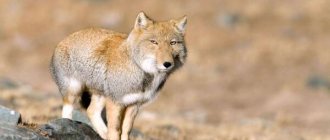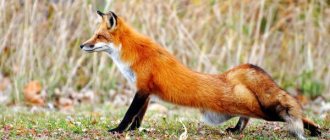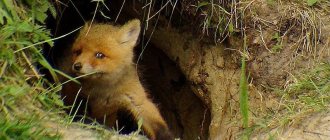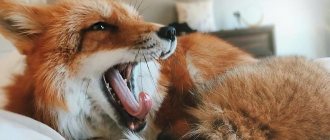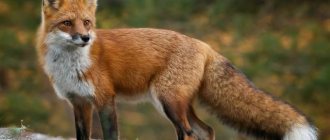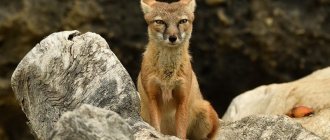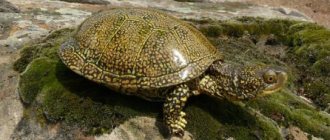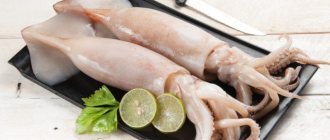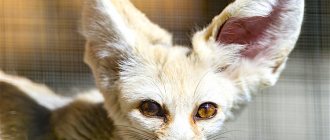The wild fox comes in three main color variations: red, cross and silver. In the most common Red variation, the color ranges from light yellowish-red (Light, Extra Light) to deep fiery red (Dark).
The next most commonly encountered fox, the cross fox gets its name from the intersection of two distinct dark stripes. The first goes along the shoulders, the second goes along the back. The basic background of the cross fox is more brownish than red, and varies from reddish to reddish brown with varying degrees of graying silver. In all shades, cross fox is darker than red fox.
An interesting mutation affects the quality of the skins. Known as "Samson", this mutation causes a lack of guard hair development and results in pelts with only a short underfur and a "cotton" appearance. “Samson” skins are usually a dark gray “smoky” color and outwardly look like they are covered with a coating, since such fur most often has sunsets.
Red foxes have one annual seasonal moult (molt), which begins in early spring and continues throughout the summer. In autumn, the underfur becomes thicker and denser, and the guard hairs reach their full length. Red fox pelts are fully mature by late November or early December and retain their quality until mid-February. However, towards the end of the season, abrasions often appear on the fur.
| Common fox forms | ||
| (a) cross | (b) red | (c) silver |
Description of the red fox
The color and body size of the fox are very diverse and depend on the habitat.
There are 40-50 subspecies of this animal. In general, in the north of their range, foxes are usually lighter and larger, while in the south they are small and dull in color. In the mountains in the north you can also find black-brown and other dark foxes. The most famous and common color for this animal: a bright red back, a white belly, and dark paws. In the area of the back and shoulder blades there are often brown stripes resembling a cross. Common features also include dark ears and white-tipped tails. Externally, the fox is a medium-sized animal with an elegant body on thin paws, an elongated muzzle, pointed ears, a long and fluffy tail. — Advertising —
Molting occurs in February-March and lasts until mid-summer. After this, the animal grows winter fur. The summer coat is short and sparse, the winter coat is thick and lush. A characteristic feature of a fox is its large ears, with which it picks up sound vibrations during the hunt.
The value of fox fur
Starting from the end of February and ending in mid-summer, the fox goes through a molting period. After the end of this period, the animal begins to grow winter fur, and it is fully formed only by November/February. Summer fur consists of a thinner undercoat, while winter fur becomes thicker and fuller. According to the nature of the fur color they are distinguished:
- Common red fox.
- Common fox.
- Common fox cross.
- Common black and brown fox.
Fox fur is highly valued at various fur auctions and industries. The largest amount of fur is mined in the territories of the southern regions, although the most valuable is the fur obtained in the northern regions, although there is not much of it.
Feeding characteristics of the red fox
Foxes are typical predators, but their diet is very diverse.
It includes more than 400 species of animals, as well as dozens of plants. Foxes rely on small rodents, mainly voles, for their diet. There are especially many of them in the winter diet of a predator: a fox is able to smell a rodent under the snow by its squeaking and rustling, and then with a quick jump dive under the snow, or scatter it with its paws in search of prey. This type of hunting is called mouse hunting. Large mammals, such as hares, are caught less frequently by foxes. Sometimes large individuals attack roe deer cubs. Birds are caught only on the ground; clutches of eggs and flightless chicks are also destroyed. Poultry is rarely hunted. Foxes, inhabitants of deserts and semi-deserts, feed on reptiles. In Canada and northeast Eurasia, near large rivers, they eat salmon that died after spawning. In the summer, foxes eat beetles and other insects and their larvae. In times of hunger they can eat carrion. Plant foods (fruits, fruits, berries) are also included in the fox’s diet, especially in the southern subspecies.
What does a fox eat in the wild?
Foxes are skilled hunters and natural predators. Their main meat dish is mice, gophers, hamsters, and other small rodents. The fox will not refuse hare meat either, but catching a nimble animal is much more difficult.
Predation of bird nests is another weakness of furry predators. Here eggs, unfledged chicks, and adult birds are used. Foxes also do not neglect plant food. They will enjoy juicy berries, fruits, and herbs with pleasure.
Folklore undeservedly attributes to foxes the glory of thunderstorming rural chicken coops. Animals can only be driven to undertake such a dangerous undertaking by severe hunger, when it is impossible to find food in the forest.
Steppe breeds often catch snakes, turtles, lizards, and frogs for lunch. In harsh mountainous areas it is more difficult to find food. Here, in search of food, animals have to run along steep cliffs and sit in ambush for hours. If birds, rodents or reptiles cannot be found, the predatory animal will be content with carrion.
Red fox distribution
The distribution range of the fox is very wide: it lives throughout Europe, in northern Africa (Egypt, Algeria, Morocco, Tunisia), in Asia (to northern India, southern China and Indochina), in North America from the Arctic to the northern Gulf of Mexico.
The fox was acclimatized in Australia, and it took root on the continent, except for the subequatorial regions. — Advertising —
Foxes are unpretentious animals and inhabit all landscape and geographical zones: from the tundra and subarctic forest to the steppe and deserts, as well as mountains. Moreover, they are found not only in the wild, but also on the outskirts of cities, inhabiting landfills, parks and basements of houses.
Introduction and distribution[edit]
Red foxes were introduced to the British colonies of Van Diemen's Land (as early as 1833) and to the Port Phillip and Sydney areas of New South Wales (as early as 1845) for the purpose of the traditional English sport of fox hunting. Curiously, there was no permanent population of foxes on the island of Tasmania, and it is widely believed that the Tasmanian devil defeated them. [3] However, the species was a successful predator on the mainland. The spread of red foxes across the southern part of the continent coincided with the spread of rabbits in Australia, another invasive species also introduced in the 19th century, which is the red fox's main prey.
Red fox behavior
Throughout their wide distribution range, foxes prefer open areas, as well as areas with isolated groves, copses, hills and ravines.
Among all climatic zones, the largest number of representatives of this species lives in the steppe and forest-steppe zone. Foxes are usually sedentary and do not migrate. During resettlement, young individuals leave the den of their parents at a distance of 2-5 to 15-30 km. A pair or group of foxes occupies the so-called family plot, where the animals dig holes on their own or occupy the homes of a badger, marmot, or arctic fox. Foxes can even live in the same hole with badgers. Animals also use natural shelters such as caves, rock crevices, and tree hollows.
Foxes usually live on the slopes of ravines and hills, in areas with sandy soil, protected from floods. Each burrow has several entrances, from which long tunnels lead to the nesting chamber. A fox's burrow is always camouflaged by dense thickets, but food debris and paths trodden to the entrances can give it away.
Foxes hunt throughout the day, but prefer early morning and late evening. In general, they are extremely careful, they know how to hide well and throw off the chase, which is why for many peoples this animal symbolizes cunning and dexterity.
Where do foxes live
In the course of evolution, foxes have successfully mastered almost all climatic zones. Fluffy animals can be found in permafrost and sultry deserts, in steppes and mountainous regions. Animals do not favor the dense taiga; they prefer sparse, spacious forest areas.
Burrows are used as shelter. Some species dig holes themselves, others occupy the abandoned homes of other animals, adapting them to their size.
The proximity of human settlements does not bother the animals. They happily settle nearby, regularly visiting in search of food. There have been cases where foxes lived in large city parks.
Red fox breeding
Foxes are monogamous animals and breed once a year.
The timing of the mating season is related to the climatic conditions of each specific subspecies. Foxes are also excellent parents. Males take care of females during pregnancy and actively participate in raising the offspring. If the father of the family dies, then a single male takes his place, and fights even occur for the right to become a stepfather. In winter, animals begin to search for places to breed their young, and carefully guard them. Unattended burrows are rare during this period; if a female dies, her den is immediately occupied by another. The female is looked after by 2-3 males, who fight among themselves all the time.
The duration of pregnancy is from 49 to 58 days. The litter ranges from 4-6 to 12-13 babies, with dark brown fur. Outwardly, they look like wolf cubs, but the tip of their tail is white. At the age of 2 weeks, fox cubs can already see and hear, and their teeth are cutting through. During this period, the female and male are very attentive and cautious, zealously protecting the offspring from danger, and they also hunt a lot to feed the babies. Milk feeding lasts 1.5 months, and the foxes are gradually accustomed to adult food and hunting. They leave the den at the age of about six months. With the onset of autumn, young males go 20-40 km from their parents, females - 10-15, in search of their own area and mate. Puberty occurs at the age of 2 years.
In the wild, foxes live from 3 to 7 years. In captivity, their life expectancy is 20-25 years.
"Red Fox" Jung Ho Young: What is known about the star of the series "Squid Game"?
The drama “Squid Game” was released on Netflix in September 2021, and within three weeks of its premiere it topped the service charts in all countries of the world. The story of debtors who take part in deadly games for a big cash prize has captivated both users and the head of Netflix. Particular attention was given to the reclusive North Korean refugee Kang Se Baek, played by 27-year-old model Jung Ho Yeon. 5-tv.ru tells what is known about the most promising actress in South Korea at the moment.
Beauty from Seoul
South Korean actress Jung Ho Yeon was born in a suburb of Seoul in 1994 and became interested in fashion at school age. She volunteered at Korean Fashion Weeks, helping organize shows and working with models. After graduating from high school, Chung entered the century-old private university Dongduk, majoring in fashion design. Her parents suggested that Ho Young become an entrepreneur, but after graduating from university, the Korean woman insisted on her own and promised her parents that she would achieve success as a fashion model. Her businessman father, the owner of a restaurant in Korea, allowed his beloved daughter to do what she liked and not worry about money.
View this post on Instagram
Posted by HoYeon Jung(Chung) (@hoooooyeony)
It was difficult not to believe young Chon: the girl has a model height, 176 centimeters, and an unusually beautiful eye shape, which was admired not only by her parents, but also by casual acquaintances. In addition, Chon was known for her brash and assertive character. Perhaps that is why the girl achieved recognition and became the most popular actress in Korea at the age of 27.
"The Red Fox of the Modeling Business"
At the beginning of her career, Ho Young realized that fashion catwalks were tired of the typical Korean type of women and dyed her hair light brown. The model’s appearance amazed the scouts who met Chon at shows. So 16-year-old Ho Yeon was invited to become a fashion model at Seoul Fashion Week. This was a great success for a newbie in the business without his own agent. At Fashion Week, editors of glossy publications saw great potential in Ho Young. She eventually appeared on the covers of Vogue Girl Korea, Elle Korea and Nylon magazines.
View this post on Instagram
Posted by HoYeon Jung(Chung) (@hoooooyeony)
In the 2010s, Jeong auditioned for the show “Korea’s Next Top Model.” Ho Young took second place in the project, but was not very upset. Already at the filming stage, she was offered work by several modeling agencies around the world. In 2016, the girl made her debut on the European catwalk in the Louis Vuitton show. Then she dyed her hair bright red and lightened her eyebrows. Ho Young decided to move to New York. The model’s unconventional appearance was appreciated in the United States, and the next season Ho Yeon walked on the catwalks of Prada, Fendi, Jacquemus, Versace and other fashion houses. The fashion model was nicknamed “the red fox of the modeling business” for her hair color.
“My height is 176 centimeters, which is average for models. If I were taller, I would be actively working in the luxury fashion industry. And if she were lower, she would be a commercial model from print magazines and TV shows. I realized that with my height, I can do both. I’m surprised that I became the model I dreamed of being,” Yeon said in an interview.
In the 2010s, Jung Ho Yeon entered into contracts with the world's leading modeling agencies and entered the top 50 famous models in the world.
"Squid Game" - Jung Ho Yeon's successful TV debut
Jung Ho Yeon became interested in acting several years ago. According to the girl, when she moved to the United States, she felt lonely. At that moment, Chong watched films in any free time - she calls her favorite films by Jim Jarmusch, Alfonso Cuaron and Quentin Tarantino, the film “Eternal Sunshine of the Spotless Mind” and the TV series “Dark”. At some point, the Korean woman thought that acting was the best way to get to know herself and her own self. Therefore, the girl spent one of her vacations taking acting courses in New York.
Jung Ho Young as Player 067 Kang Se Baek in "Squid Game". Photo: Global Look Press/Netflix
The girl managed to implement the acquired skills only in 2019, when Jung Ho Yeon received an invitation to the casting for “The Squid Game.” She auditioned as one of the last contenders for the role and thought that the director would not like her - they say, her gait was too model-like and her height was too tall for a pickpocket heroine. She was sent only three parts of the script, so the actress did not know how to impress the casting directors.
“I only received three parts of the script before the audition. They included scenes with Se Baek's younger brother, a North Korean broker, and a conversation with Gi Heon from the penultimate episode. I didn't have much context. I had to use my imagination to fill in the gaps,” the actress later admitted.
Chung doubted herself even after she was informed that she had received the coveted role. The girl was afraid to let down the large film crew, so she kept asking the creators what her heroine should be like. But the director of the project, Hwang Dong-hyuk, convinced the girl that he expected from her the sincerity and complex character of the model herself. The experience of working in front of the camera helped Chung transform into a refugee from North Korea. Later, the girl will say that she and her heroine have a lot in common - both left their homeland for a better life, both have difficulty opening up to people. The pickpocket Sae Baek, performed by the aspiring actress, was so liked by the audience that thousands of videos made by enthusiastic fans appeared online.
From model to Instagram diva
Thanks to the successful launch of “The Squid Game,” Jung Ho Yeon has significantly increased her audience on the social network Instagram. Before the project, 400 thousand people subscribed to it, and in three weeks the number of subscribers increased to 19 million. The Korean woman's blog was named the fastest growing in the history of the social network! Jung Ho Yeon was recognized as the most popular actress in South Korea. From a catwalk model, the girl “grew up” to become an ambassador for the Louis Vuitton brand, where she once began her career. In addition, Ho Young became the face of the Adidas brand.
These regalia do not prevent Jung Ho Yeon from running the page at her own discretion. On her blog, she posts funny pictures, admires fan drawings, and shares photos of her personal life. The actress is close friends with Jennie, a member of the world famous k-pop group BLACKPINK.
View this post on Instagram
Posted by HoYeon Jung(Chung) (@hoooooyeony)
In the comments, Chon is constantly confessing his love. But the heart of the beauty from Seoul has long been occupied. For more than six years, she has been dating South Korean actor Lee Dong Hwi, who is nine years older than her. In his homeland, he is known for the box office hits “The Maid” and “Extreme Job” and is considered one of the most popular actors in South Korea. Thanks to “The Squid Game,” in 2021, Chon significantly overtook her chosen one in popularity. But the girl says that while working on the series, their relationship only grew stronger: Lee supported her all the time and shared his own experience in the film industry.
Speaking about her future plans, Jung Ho Yeon is thinking about participating in the second season of the famous hit if she gets the opportunity.
"Life goes on. I just want to boldly move forward and explore the world,” Ho Young is sure.
The girl has already received several offers to star in full-length films, but she is not going to plunge into cinema headlong - not all the fashion catwalks of the world have yet been conquered by the “red fox”.
Natural enemies of the red fox
The red fox population varies from year to year, but is generally high. The condition is affected by the number of rodents, climate, and infectious diseases. In hungry years, the fertility of females decreases, fewer puppies survive, and epizootics such as rabies, plague, and scabies spread. If there is enough food, then the number of foxes increases.
Current distribution[edit]
An exotic fox in Mornington Peninsula National Park with mange.
Established populations of the red fox occur in all states and are widespread throughout the country, except in tropical areas of northern Queensland, the Kimberley and the Top End of the Northern Territory. Since 2010, confirmed evidence of foxes in Tasmania has been reported by the Government's Department of Primary Industries, Parks, Water and Environment. [4] Foxes are found in even higher concentrations in densely populated suburban areas and large cities such as Melbourne. [5]
It tends to be less common in regions where dingoes are more common; however, it has, primarily through its burrowing behavior, achieved niche differentiation with both the wild dog and wild cat.
Interesting facts about the red fox:
- Foxes have a well-developed sense of smell and hearing. Their vision is adapted to the dark: they respond well to movement, but do not recognize color well, especially in the daytime.
- An excited animal emits a sharp, loud bark, and squeals during fights. It is by their voice that one can distinguish between a female and a male: the former is characterized by a triple “bark”, with a short howl at the end, while the male barks like a dog and never howls.
- The economic importance of the fox lies in the fact that it is a valuable fur-bearing animal, which also regulates the number of rodents and insects in nature.
- In order to obtain fur, foxes are specially bred in captivity. At the end of the 19th century, a breed of silver-black (silver-brown) fox was artificially bred. With the help of selection, the quality of her fur was improved, and on its basis, scientists developed a number of fur breeds: platinum, Bakurian, Dakota.
Catalog Section I
| Code | Description | Definition |
| SEL | SELECTED | Best possible quality. The pubescence is dense throughout the skin, the underfur is well closed. No vices. |
| I | FIRST gr. | A very good quality. Completely closed skins, with the exception of the sides, where some weakness of the covering hair is allowed. No vices. |
| I-II | FIRST AND SECOND gr. | Very noticeable sparseness of covering hair on the sides and back. The elasticity of the fur is reduced. |
| II | SECOND gr. | Very weak open sides and back. Very sparse undercoat. |
| SDG | MILDLY DAMAGED | SDG (Gd./Good): Selected or I quality skins with damage up to 10%. SDG (Av./Medium): Skins of quality I-II and II with damage up to 10%. |
Appearance of animal fox
The fox animal belongs to the class of mammals. Depending on the species, its size ranges from 0.18 to 0.9 m. The weight of the predator varies similarly - from 700 g to 10 kg.
All types have the following characteristics:
- elongated muzzle shape;
- elongated body;
- shortened paws.
The pride of any red-haired rogue is her bushy tail. It performs not only an aesthetic task, but also a practical function, playing the role of a stabilizer while running. In addition, in severe winters, the tail can help the animal protect itself from frost. It can be from 0.4 to 0.6 m in length.
The fox is famous for its sense of smell and perfectly hears the slightest rustle. And she also sees perfectly. And not only during the day, but also at night. The only disadvantage of fox vision is the ability to distinguish colors. Most species have 42 teeth in their mouths. The exception is the big-eared fox. She has 48 of them.
The photo of the fox shows that the fur of this predator has a red tint. Its density is influenced by several factors: species, habitat, season. For example, foxes living in the north have thick, warm fur on their bodies in winter. In the summer, the splendor of their “fur coat” noticeably decreases.
Genus Otocyon (Big-eared foxes)
Big-eared fox Otocyon megalotis
Two populations are known: one occurs from the south of Zambia to South Africa, the other from Ethiopia to Tanzania. Prefers open spaces.
Body length - 46-58 cm, tail - 24-34 cm, weight - 3-4.5 kg. The color ranges from gray to dark yellow, there are black markings on the face, tips of the ears and paws, and a “strap” on the back. The ears are large (up to 12 cm). The big-eared fox differs from other species in its unusual dental structure: its teeth are weak, but together with additional molars their total number is 46-50. The diet of this species is also very unusual: 80% of the diet consists of insects, mainly dung beetles and termites.
Genus Urocyon (Grey foxes)
Gray fox Urocyon cinereoargenteus
Found from the central United States to the prairies, from the south to Venezuela, from the north to Ontario.
Body length – 52-69 cm, tail – 27-45 cm, weight – 2.5-7 kg. The color is gray, with streaks, the throat is white, the paws are reddish-brown. A ridge of stiff black hairs runs along the dorsal surface of the tail.
Island fox Urocyon littoralis
Distributed on the Channel Islands near California.
This is the smallest species of fox found in the United States. Body length - 48-50 cm, tail -12-29 cm, weight - 1.2-2.7 kg. Outwardly similar to the gray fox, but inferior to it in size. The island fox is mostly insectivorous.
